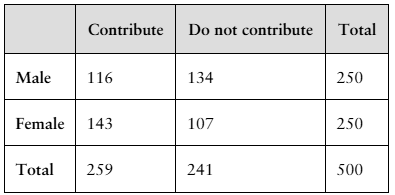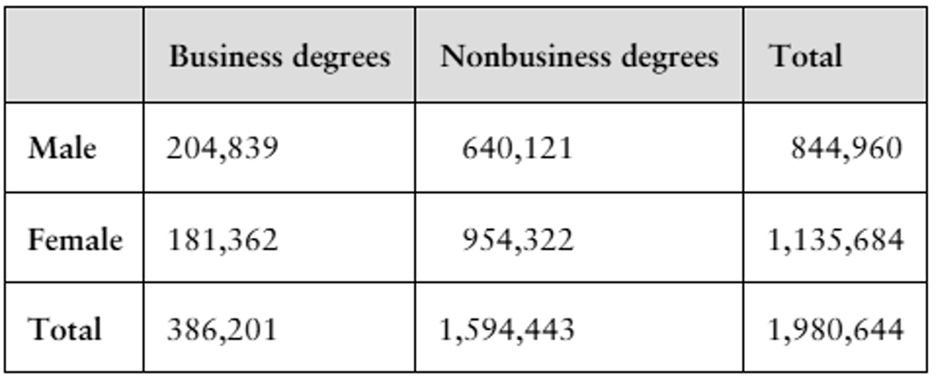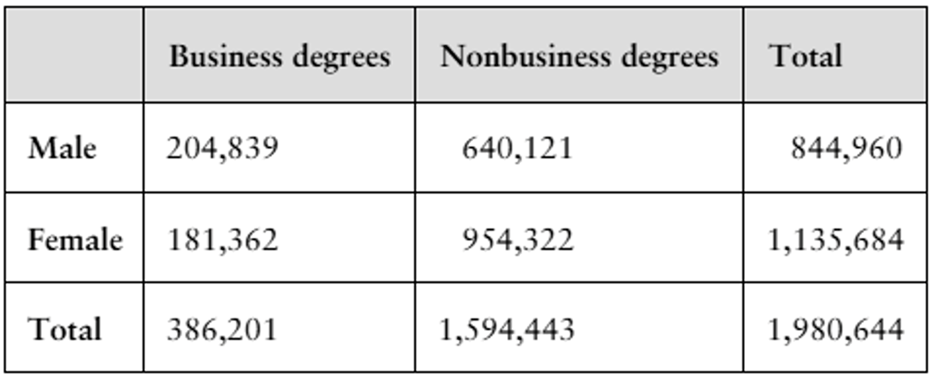 Back
BackProblem 3.2.35
"According to Bayes’ Theorem, the probability of event A , given that event B has occurred, is
P(A|B) = P(A) * P(B|A)P(A) * P(B|A) + P(A') * P(B|A').
In Exercises 33–38, use Bayes’ Theorem to find P(A|B).
35. P(A) = 0.25, P(A') = 0.75, P(B|A) = 0.3 , and P(B|A') = 0.5 "
Problem 3.2.8a
"Finding Conditional Probabilities In Exercises 7 and 8, use the table to find each conditional probability.
8. Retirement Savings The table shows the results of a survey in which 250 male and 250 female workers ages 25 to 64 were asked if they contribute to a retirement savings plan at
work.
a. Find the probability that a randomly selected worker contributes to a retirement savings plan at work, given that the worker is male.
"
Problem 3.2.23a
Using the Multiplication Rule In Exercises 19-32, use the Multiplication Rule.
23. Celebrities as Role Models In a sample of 1103 probable voters, three out of four say they would like entertainers to address social and political issues. Two probable voters are selected at random. (Source: The Hollywood Reporter)
a. Find the probability that both probable voters would like entertainers to address social and political issues.
Problem 3.2.24a
Using the Multiplication Rule In Exercises 19-32, use the Multiplication Rule.
24. Knowing a Person Who Was Murdered In a sample of 11,771 children ages 2 to 17, 8% have lost a friend or relative to murder. Four children are selected at random. (Adapted from University of New Hampshire)
a. Find the probability that all four have lost a friend or relative to murder.
Problem 3.2.25a
Using the Multiplication Rule In Exercises 19-32, use the Multiplication Rule.
25. Best President In a sample of 1500 adult U.S. citizens, 270 said that Barack Obama was the best president in U.S. history. Two adult U.S. citizens are selected at random.
(Adapted from YouGov)
a. Find the probability that both adult U.S. citizens say that Barack Obama was the best president in U.S. history.
Problem 3.2.25d
Using the Multiplication Rule In Exercises 19-32, use the Multiplication Rule.
25. Best President In a sample of 1500 adult U.S. citizens, 270 said that Barack Obama was the best president in U.S. history. Two adult U.S. citizens are selected at random.
(Adapted from YouGov)
d. Which of the events can be considered unusual? Explain.
Problem 3.2.26c
Using the Multiplication Rule In Exercises 19-32, use the Multiplication Rule.
26. Worst President In a sample of 1500 adult U.S. citizens, 690 said that Donald Trump was the worst president in U.S. history. Three adult U.S. citizens are selected at random.
(Adapted from YouGov)
c. Find the probability that at most two of the three adult U.S. citizens say that Donald Trump was the worst president in U.S. history.
Problem 3.2.27c
Using the Multiplication Rule In Exercises 19-32, use the Multiplication Rule.
27. Blood Types The probability that a person of Asian descent in the United States has type O+ blood is 39%. At random, six people of Asian descent in the United States are selected. (Source: American National Red Cross)
c. Find the probability that at least one of the six has type O+ blood.
Problem 3.2.28b
Using the Multiplication Rule In Exercises 19-32, use the Multiplication Rule.
28. Blood Types The probability that a Latinx American person in the United States has type A+ blood is 29%. Four Latinx American people in the United States are selected at random. (Source: American National Red Cross)
b. Find the probability that none of the four have type A+ blood.
Problem 3.2.29a
Using the Multiplication Rule In Exercises 19-32, use the Multiplication Rule.
29. In Vitro Fertilization In a recent year, about 1.9% of all infants born in the U.S. were conceived through assisted reproductive technology (ART). Of the ART deliveries, about 26.4% resulted in multiple births. (Source: Morbidity and Mortality Weekly Report)
a. Find the probability that a randomly selected infant was conceived through ART and was part of a multiple birth.
Problem 3.2.30b
Using the Multiplication Rule In Exercises 19-32, use the Multiplication Rule.
30. Standardized Test Scores According to a survey, 57.8% of college-seeking high school seniors say they have taken one of the standardized tests for potential college students. Of these, 35.6% say they do not plan to submit their score with their college applications. (Adapted from Niche)
b. Find the probability that a randomly selected college-seeking high school senior took one of the standardized tests and plans to submit this score with their college
applications.
Problem 3.2.1
3. What does the notation P(B|A) mean?
Problem 3.2.6
True or False? In Exercises 5 and 6, determine whether the statement is true or false. If it is false, rewrite it as a true statement.
6. If events A and B are dependent, then P(A and B) = P(A) · P(B).
Problem 3.2.8b
Finding Conditional Probabilities In Exercises 7 and 8, use the table to find each conditional probability.
8. Retirement Savings The table shows the results of a survey in which 250 male and 250 female workers ages 25 to 64 were asked if they contribute to a retirement savings plan at
work.
b. Find the probability that a randomly selected worker is female, given that the worker contributes to a retirement savings plan at work.
Problem 3.2.11
Classifying Events as Independent or Dependent In Exercises 9-14, determine whether the events are independent or dependent. Explain your reasoning.
11. Returning a rented movie after the due date and receiving a late fee
Problem 3.2.14
Classifying Events as Independent or Dependent In Exercises 9-14, determine whether the events are independent or dependent. Explain your reasoning.
14. A ball is selected from a bin of balls numbered from 1 through 52. It is replaced, and then a second numbered ball is selected from the bin.
Problem 3.2.17
Classifying Events Based on Studies In Exercises 15-18, identify the two events described in the study. Do the results indicate that the events are independent or dependent? Explain your reasoning.
17. A study found that there is no relationship between playing violent video games and aggressive or bullying behavior in teenagers. (Source: The Royal Society Publishing)
Problem 3.2.20
Using the Multiplication Rule In Exercises 19-32, use the Multiplication Rule.
20. Coin and Die A coin is tossed and a die is rolled. Find the probability of tossing a tail and then rolling a number greater than 2.
Problem 3.2.37
According to Bayes’ Theorem, the probability of event A , given that event B has occurred, is
P(A|B) = P(A) * P(B|A)P(A) * P(B|A) + P(A') * P(B|A').
In Exercises 33–38, use Bayes’ Theorem to find P(A|B).
37. P(A) = 73%, P(A') = 17%, P(B|A) = 46% , and P(B|A') = 52%
Problem 3.2.34
"According to Bayes’ Theorem, the probability of event A , given that event B has occurred, is
P(A|B) = P(A) * P(B|A)P(A) * P(B|A) + P(A') * P(B|A').
In Exercises 33–38, use Bayes’ Theorem to find P(A|B).
34. P(A) = 3/8, P(A') = 5/8, P(B|A) = 2/3 , and P(B|A') = 3/5 "
Problem 3.2.38
"According to Bayes’ Theorem, the probability of event A , given that event B has occurred, is
P(A|B) = P(A) * P(B|A)P(A) * P(B|A) + P(A') * P(B|A').
In Exercises 33–38, use Bayes’ Theorem to find P(A|B).
38. P(A) = 12%, P(A') = 88%, P(B|A) = 66% , and P(B|A') = 19% "
Problem 3.2.39a
"39. Reliability of Testing A virus infects one in every 200 people. A test used to detect the virus in a person is positive 80% of the time when the person has the virus and 5% of the time when the person does not have the virus. (This 5% result is called a false positive.) Let A be the event ""the person is infected"" and B be the event ""the person tests positive.""
a. Using Bayes' Theorem, when a person tests positive, determine the probability that the person is infected."
Problem 3.2.7a
Finding Conditional Probabilities In Exercises 7 and 8, use the table to find each conditional probability.
7. Business Degrees The table shows the numbers of male and female students in the United States who received bachelor's degrees in business and nonbusiness fields in a recent year. (Source: National Center for Educational Statistics)
a. Find the probability that a randomly selected bachelor's degree-earning student is male, given that the degree is in business.
Problem 3.2.7b
Finding Conditional Probabilities In Exercises 7 and 8, use the table to find each conditional probability.
7. Business Degrees The table shows the numbers of male and female students in the United States who received bachelor's degrees in business and nonbusiness fields in a recent year. (Source: National Center for Educational Statistics)
b. Find the probability that a randomly selected bachelor's degree-earning student received a business degree, given that the student is female.
Problem 3.2.23b
"Using the Multiplication Rule In Exercises 19-32, use the Multiplication Rule.
23. Celebrities as Role Models In a sample of 1103 probable voters, three out of four say they would like entertainers to address social and political issues. Two probable voters are selected at random. (Source: The Hollywood Reporter)
b. Find the probability that neither probable voter would like entertainers to address social and political issues."
Problem 3.2.23c
"Using the Multiplication Rule In Exercises 19-32, use the Multiplication Rule.
23. Celebrities as Role Models In a sample of 1103 probable voters, three out of four say they would like entertainers to address social and political issues. Two probable voters are selected at random. (Source: The Hollywood Reporter)
c. Find the probability that at least one of the two probable voters would like entertainers to address social and political issues."
Problem 3.2.24b
"Using the Multiplication Rule In Exercises 19-32, use the Multiplication Rule.
24. Knowing a Person Who Was Murdered In a sample of 11,771 children ages 2 to 17, 8% have lost a friend or relative to murder. Four children are selected at random. (Adapted from University of New Hampshire)
b. Find the probability that none of the four has lost a friend or relative to murder."
Problem 3.2.24c
"Using the Multiplication Rule In Exercises 19-32, use the Multiplication Rule.
24. Knowing a Person Who Was Murdered In a sample of 11,771 children ages 2 to 17, 8% have lost a friend or relative to murder. Four children are selected at random. (Adapted from University of New Hampshire)
c. Find the probability that at least one of the four has lost a friend or relative to murder."
Problem 3.2.25b
"Using the Multiplication Rule In Exercises 19-32, use the Multiplication Rule.
25. Best President In a sample of 1500 adult U.S. citizens, 270 said that Barack Obama was the best president in U.S. history. Two adult U.S. citizens are selected at random.
(Adapted from YouGov)
b. Find the probability that neither adult U.S. citizen says that Barack Obama was the best president in U.S. history."
Problem 3.2.25c
"Using the Multiplication Rule In Exercises 19-32, use the Multiplication Rule.
25. Best President In a sample of 1500 adult U.S. citizens, 270 said that Barack Obama was the best president in U.S. history. Two adult U.S. citizens are selected at random.
(Adapted from YouGov)
c. Find the probability that at least one of the two adult U.S. citizens says that Barack Obama was the best president in U.S. history."




